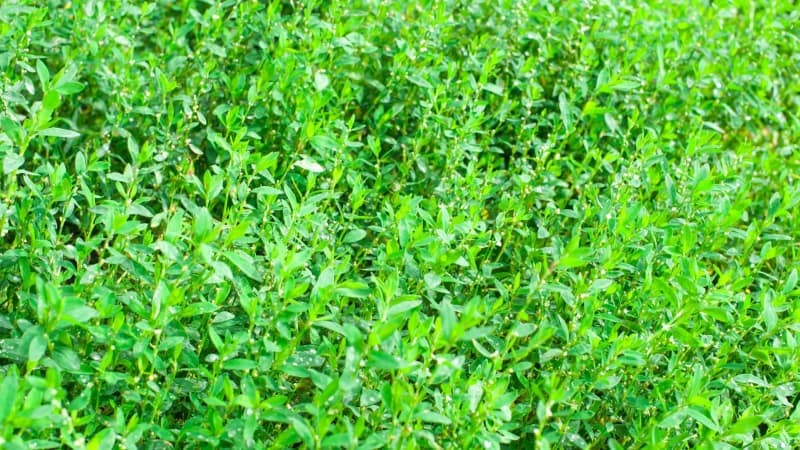Known for its medicinal properties, bird’s-foot rush is a plant with a wide range of uses in natural medicine. In this article, we look at its health benefits, how to identify it, its use in the treatment of various ailments, and discuss potential side effects and methods of ecological control.
Bird’s milkweed properties – a natural treasure in folk medicine
Bird‘s milkweed, also known as Polygonum aviculare, has enjoyed a reputation in folk medicine for centuries. Its popularity is due to its wealth of active ingredients, which have beneficial effects on health. Among them are flavonoids, phenolic acids, vitamins (including vitamin C) and minerals such as potassium, magnesium and calcium. These substances contribute to the many health-promoting properties of bird’s-foot knotweed.
Bird ‘s knotweed is valued primarily for its anti-inflammatory and antioxidant effects. Flavonoids present in the plant help neutralize free radicals, which is crucial in preventing the body from aging and developing many diseases. In addition, this herb exhibits diuretic action, which makes it helpful in removing toxins from the body.
It is also worth mentioning the use of bird ‘s chard in the treatment of skin ailments. Thanks to its anti-inflammatory and tissue regeneration-accelerating properties, it is effective in relieving inflammatory skin conditions such as acne and eczema. In addition, external application of knotweed preparations can provide relief from minor wounds and abrasions.
An interesting aspect of bird ‘s eye knotweed is its effect on the respiratory system. The plant is sometimes used as an expectorant, making it helpful in treating coughs and other respiratory ailments. In addition, bird’s-foot trefoil can support cardiovascular function, helping to lower blood pressure and improve circulation.
What bird’s eye knotweed looks like – identification and occurrence
Bird’s milkweed, known scientifically as Polygonum aviculare, is a plant that can be easily identified by its characteristic features. It is a small, often inconspicuous plant that can reach a height of 15 to 60 cm. It is characterized by thin, branching stems that often lay horizontally on the ground, forming dense carpets.
The leaves of bird’s-eye knotweed are small, oval or lanceolate, with distinct parallel veins. They are placed on short petioles and have a characteristic dark green color. Knotweed flowers are small, usually white or pinkish, and appear from spring to autumn. They are grouped in small, spike-like inflorescences that develop in the angles of the leaves.
Bird’s-foot knotweed is a very hardy plant that is adapted to a wide variety of environmental conditions. It can be found almost anywhere, from urban areas, gardens, fields to roads and wastelands. Its versatility and ability to spread quickly mean that it is often considered a weed.
It’s worth noting how bird’s-foot trefoil knotweed looks, as it’s a plant often confused with other species. Differentiating bird’s eye knotweed from similar plants is important, especially in the context of its medicinal use. It is important to remember that not all plants with a similar appearance have the same properties and can be used safely.

Bird’s eye knotweed herb – traditional uses and modern research
Bird’s knotweedherb has been recognized in traditional folk medicine for centuries. Its uses were known as far back as antiquity, where it was used to treat many ailments. Traditionally, it was used as an anti-inflammatory, anti-diarrheal, and to treat skin and respiratory problems.
Modern scientific research confirms many of these traditional uses. Studies have shown that bird’s milkweed has strong antioxidant properties, so it can help protect the body from free radical damage. In addition, its anti-inflammatory effects have been confirmed, making it effective in relieving inflammation of various origins.
An interesting area of research on bird’s choke herb is its effect on the cardiovascular system. Some studies suggest that it may have beneficial effects on lowering blood pressure and improving the elasticity of blood vessels. This makes it likely to be a valuable ingredient in the prevention of cardiovascular disease.
Avian knotweed is also being studied for its potential effects on the digestive system. Its anti-diarrheal and anti-inflammatory properties may be helpful in treating various gastrointestinal ailments, including irritable bowel syndrome or stomach ulcers.
It is also worth noting studies on the antibacterial and antiviral effects of bird’s-foot trefoil. Preliminary results suggest that it may have activity against some pathogens, which opens new possibilities for the use of this plant in medicine.
Bird knotweed control – ecological methods and their effectiveness
Although valued for its medicinal properties,bird‘s-foot knotweed is often considered a weed, especially in agriculture and horticulture. Its ability to spread quickly and adapt to different environments means it can be difficult to control. However, there are ecological methods of controlling this species that are both effective and safe for the environment.
One method is the use of mulching, which involves covering the soil with a layer of organic material. Mulch can limit the growth of bird’s-foot trefoil by blocking light, which inhibits its germination. In addition, mulching helps maintain soil moisture and improves soil structure, which benefits crops.
Another organic method is to use crop rotation and intercropping. Changing crops in the field can make it difficult for bird’s-foot trefoil knotweed to adapt and spread. Intercrops, such as legumes, can competitively displace the knotweed while enriching the soil with nitrogen.
Proper soil care is also an important aspect in bird’s-foot knotweed control. Regular soil loosening and aeration can hinder the development of knotweed roots, limiting its growth. In addition, maintaining proper soil pH levels and fertility can promote crop growth while inhibiting weed growth.
For smaller areas, such as gardens, manual removal of bird’s-foot trefoil knotweed can be an effective method. Regular uprooting of the plant along with its roots can gradually reduce its presence. This is a labor-intensive but highly effective method, especially when combined with other gardening practices.
Birdweed side effects
Although bird’s-foot knotweed is prized for its many medicinal properties, it is important to be aware of the potential side effects and precautions associated with its use. Like any medicinal plant, bird’s eye knotweed can cause adverse reactions, especially with misuse or overdose.
One potential side effect is the risk of allergy. People with hypersensitivity to bird’s eye knotweed or other plants in the knotweed family may experience allergic reactions such as skin rash, itching, or swelling. If allergic symptoms occur, stop using bird’s eye knotweed immediately and consult a doctor.
Another important aspect is the effect of bird ‘s-foot chickweed on the absorption of certain nutrients. Bird’s knotweed contains a so-called antithiamin factor, which can contribute to the breakdown of vitamin B1 (thiamine). Long-term use of bird’s-foot knotweed in large quantities can lead to a deficiency of this vitamin, which can have negative health consequences.
People suffering from certain medical conditions, such as kidney disease or kidney stones, should be especially careful when using bird’s-foot knotweed. Due to its diuretic effect, knotweed can affect the body’s water and electrolyte balance, which can be dangerous for people with kidney problems.
When using bird’s eye knotweed, it is also important to be aware of potential drug interactions. The plant can interact with certain medications, including anticoagulants, which can lead to changes in their effectiveness. It is always advisable to consult a doctor before starting to use bird’s eye knotweed, especially if you are taking other medications.
Summary: Bird’s eye knotweed – properties and side effects.
In this article we have introduced the topic of bird’s-foot chickweed, focusing on its medicinal properties, methods of identification, traditional and modern use, methods of ecological control and potential side effects. Birds’ knotweed, as a plant with a rich spectrum of activities, plays an important role in both folk medicine and modern pharmacology. However, like any active substance, it requires proper use and awareness of potential risks. Knowledge of these aspects allows safe and effective use of this fascinating plant.

